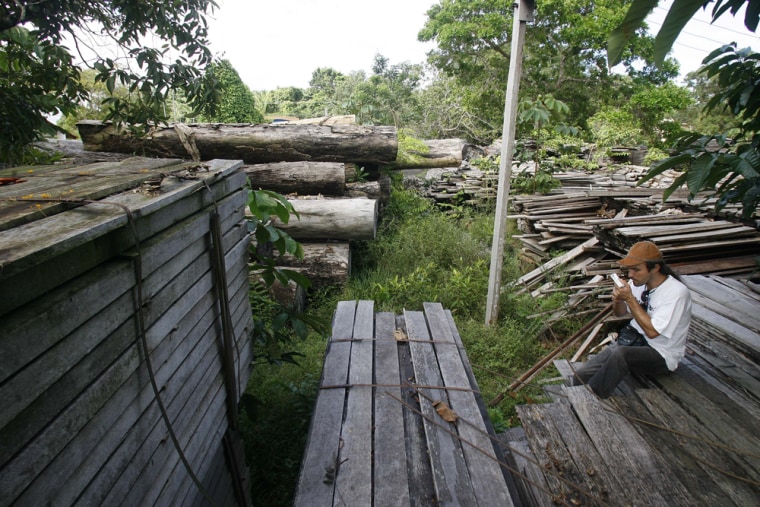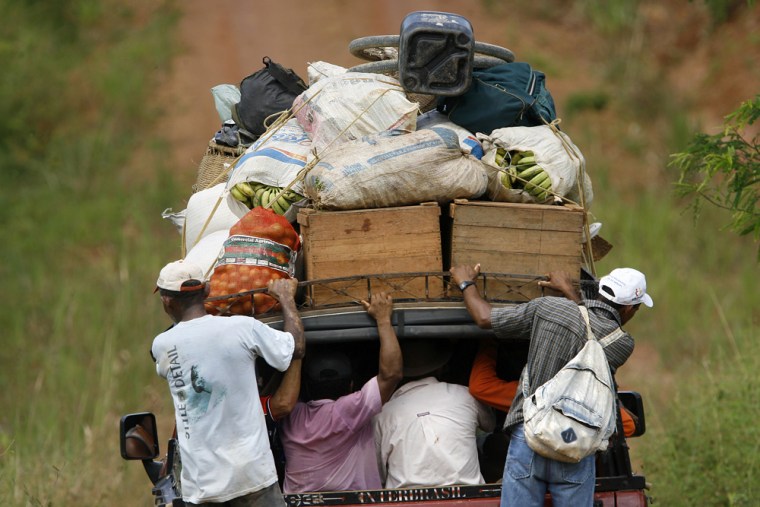Izidio Orlando de Brito used to walk for hours down a jungle path hauling his manioc, beans, corn and rice to market, thinking how much easier life would be if there was a road to his village.
The road finally arrived, and with it bad news. The land Brito and his neighbors considered their own was actually inside Amazonia National Park, and the government wanted them out.
But to go where? It was Brito’s home — a remote Amazon region that is officially off-limits but in reality is just a poorly mapped, under-policed wilderness.
“We came here because we had nowhere else to go. No one said anything about it being a national park. It was only when the road arrived that they came and told us,” Brito said, standing outside the crude house he fashioned out of tree branches and mud in a jungle hamlet called Sao Manuel, some 1,550 miles northwest of Rio de Janeiro.
Officially, some 180,000 square miles, just over 10 percent of Brazil’s Amazon rain forest, are under some form of environmental protection, such as parks and national forests.
The government says it plans to increase the protected area by 84,000 square miles over the next three years.
Mapping leads to protest
But in truth, many of these protected areas exist only on paper. And when the government recently set out to map Amazonia, hundreds of poor settlers blocked the effort by invading the offices of Ibama, the national environmental agency, in Itaituba, the town nearest to the disputed land.
Following the 2005 murder of Dorothy Stang, an American nun and rain forest defender, President Luiz Inacio Lula da Silva put another 19,900 square miles of Amazon land under federal protection. But so far Ibama has only appointed a few administrators and hasn’t mapped the parks’ borders.
The fact that 13 years have passed since the road reached Brito’s village, and the settlers are still there, is indicative of the slow pace of government enforcement.
Mapping is better than nothing, but far from ideal, environmentalists say.
Protecting the rain forest cuts both ways. Simply declaring an area protected may deter loggers, but it also makes that same area a haven for farmers being chased off privately owned ranch land, often at gunpoint.
“Ibama can’t kill people. Ranchers can and do kill people,” says Poliana Francis, the environmental agency’s manager of the Amazonia National Park where Brito lives.
What to do with families?
There are no official statistics on the squatters’ numbers, but a visit to the eastern Amazon suggests the problem is widespread, and the number of families illegally living in national parks is probably in the thousands.
About 300 families are believed to be living in Amazonia, a wilderness half the size of New Jersey, says Elza Lilia Gomes, a consultant from the U.N. Development Program who works at Amazonia.

“The average settler family only cuts down about five hectares (13 acres). But five hectares times 300 families adds up,” said Gomes.
“The question is, do we relocate them — which we don’t have the money for — or do we redraw the park’s borders to exclude the communities?” she added. “The problem with redrawing the borders is it leaves large groups which are only likely to expand into the park in the future.”
Clandestine logging adds to the destruction.
The road to Sao Manuel arrived thanks to Wirland Freire, then mayor of Itaituba, who used it to log over 1,700 acres of virgin forest inside the national park before being caught and fined.
In 2004, logger and rancher Walmir Climaco was fined 1.1 million reals ($531,000) for cutting down 1,940 acres inside the park.
Few forest rangers
Even when the parks have some degree of infrastructure, it is rarely sufficient to patrol vast expanses. According to the environmental group Vitoria Amazonica, Brazil has one forest ranger for every 650 square miles at its 278 federal preserves.
That number falls sharply in the Amazon, which many rangers shun because of the isolation and threats from loggers.
Amazonia National Park has a staff of six, including just two forest rangers. Francis says she would need at least 30 rangers to patrol it properly.
By comparison, Arizona’s Tonto National Forest, which is roughly the same size as Amazonia National Park, has about 400 full-time employees.
Some environmentalists propose allowing people to live in the forest and harvest its fruits, nuts and rare oils without cutting it down. But although studies have shown that harvesting the forest can be more lucrative than farming it, few settlers have the know-how to put it into practice.
